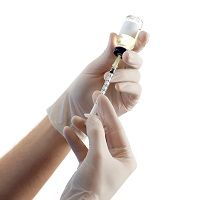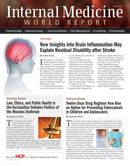Publication
Article
Internal Medicine World Report
A Different Look at Vaccinations
Author(s):
The author reviews several important changes to this year's vaccine recommendations for adults and children from the CDC.

In the midst of the media attention to measles vaccine, the concepts of herd immunity, and the pundits and politicians taking a stand on the appropriate role of childhood immunization, the CDC released the annual update to their vaccine recommendations for adults and children. These recommendations come from their Advisory Committee on Immunization Practices (ACIP) and a include a number of changes that are worth noting.
Pneumococcal Vaccine
Pneumococcal infection is a leading cause of bacteremia, meningitis, and pneumonia among adults, causing approximately 4,000 deaths per year. Prevention through vaccination remains highly underused.
The 13-valent pneumococcal conjugate vaccine (Prevnar13, PCV13) is indicated for all children, for those aged 6-18 years who are about to have a splenectomy or have lost their spleen, with sickle cell disease, a weakened immune systems, with CSF fluid leaks, or cochlear implants AND for all unvaccinated adults at or over 65 years.
The 23-valent pneumococcal polysaccharide vaccine (PPSV23) is recommended for adults aged 19 and older who have risk factors (renal disease, tobacco abuse, asthma, chronic heart disease, chronic lung disease, and altered immune system) AND for all adults aged 65 years and older. When PPSV23 is given to adults before the age of 65, it is recommended to give a second dose 5 years after the first dose.
The indications and methods of delivery of these vaccines in adults is unfortunately complicated, but in light of the pneumococcal disease implications, worth considering. To simplify, follow the guidelines below:
- At age 19, all high risk adults should receive the PPSV23 vaccine
- At age 50, all adults should receive the PCV13 vaccine
- At age 65, all adults who have not previous received either PCV13 or PPSV23 should receive the PCV13 vaccine, follow by PPSV23 6 to 12 months later (minimum 8 weeks)
If a patient has already received the PPSV23 (due to high risk status) before age 65, upon turning 65 they should receive the PCV13 vaccine at least 1 year after the PPSV23 vaccine and then receive a second dose of PPSV23 6 to 12 months after the PCV13 dose (minimum 8 weeks).
The interval between two PPSV23 doses is >=5 years.
In persons who already received PPSV23 at age >=65, one PCV13 should be given >=1 year after.
Contraindications to the PPSV23 and/or PCV13 include history of life-threatening reaction to either vaccine or severe allergy to vaccine ingredients. While side effects are common with the vaccines, they are most often mild (mild swelling, redness, etc.). Very rarely, severe reactions occur and should be reported to the Vaccine Adverse Event Reporting System. The CDC provides additional information on this topic.
Human Papilloma Virus
There is a new vaccine against human papillomavirus (HPV), Gardasil 9, which shows very high efficacy against cancer causing HPV strains. This vaccine covers HPV 6, 11, 16, and 18 (as the current vaccine does) plus types 31, 33, 45, 52, and 58.
Among approximately 14,000 females who were HPV-negative at study entry, the nine-valent vaccine effectively prevented over 96% of high-grade cervical, vaginal, or vulvar neoplasia or cancers related to the five additional strains. Antibody titers against the four original strains were similar in the two groups, suggesting that the additional antigens did not compromise protection against these viral types.
The successful addition of five more HPV types to the vaccine should extend the prevention of HPV-related cervical cancer to 90%. Vaccine utility in the US remains problematic, however, with only 57% of eligible girls having received one or more dose of HPV vaccine. Reasons include lack of insurance coverage, inconvenience of the three-dose regimen, limited wholehearted support from pediatricians, and moral and religious attitudes in certain parts of the country.
Adverse outcomes are a common rationale patient’s offer when declining this vaccine. Recent data has disproven the myth that HPV vaccination increases promiscuity and STI risk (JAMA Internal Medicine (2015): 9 Feb. 2015). And the HPV vaccine does NOT cause death from Guillian Barre Syndrome, or other paralytic disorders. But like the Hepatitis B vaccine, it is a vaccine that prevents cancer, and is very safe.
Although not immediately pertaining toward your practice, other changes you should be aware of include:
Meningococcal vaccine
There are about 500 cases of meningococcal disease in the US per year, with about 30% coming from N. meningitidis serogroup B, resulting in a 10-15% mortality rate. While the risk is relatively low in the US, meningococcal disease is more common in the rest of the world, and a recent outbreak at Princeton University in New Jersey led the CDC to update their recommendations.
The older versions of vaccines for meningococcal disease were designed to cover four of the five serotypes. With the addition of two new serogroup B coverage meningococcal vaccines, Trumenba and Bexsero, the FDA now expands the coverage to a fifth serotype. These vaccines will soon be available for young adults.
Until this is available, there are changes to the pediatric vaccination recommendations regarding the current meningococcal conjugate vaccine (MenHibrix, Menactra, or Menveo):
- Those who are not at increased risk, it is recommended that one dose of Menactra or Menveo be given at age 11 through 12 years with a second dose at age 16 years;
- Adolescents aged 11 and older with HIV infection should receive two doses of Menactra or Menveo, at least 8 weeks apart.
- Children who are aged 2 months and older who have multiple risk factors or high-risk conditions (those without a spleen, those with persistent compliment deficiency, and those traveling to high risk or endemic countries (Africa in particular) should receive immunization; for those with functional or anatomic asplenia, use Menveo® or MenHibrix® or wait until 2 years of age to receive Menactra; for those with complement deficiencies or traveling to high risk locations, use any of the vaccines.
- Children who are living or traveling to an area where a recent meningitis outbreak has recently occurred should receive age-appropriate immunization series beginning prior to their trip.
Influenza Vaccine
Concerning the 2014-2015 influenza season vaccine, new recommendations are for children aged 6 months to 8 years of age to receive two doses of either the inactivated influenza vaccine or the live attenuated influenza vaccine, four weeks apart. This should be given to children who are receiving influenza vaccine for the first time, who did not receive at least one dose of the 2013-14 influenza vaccine, or who did not receive at least two doses of the seasonal influenza vaccine since July of 2010. Otherwise, the child needs only 1 influenza vaccine dose for 2014-2015 season. At the beginning of age 9, only one annual dose is now required.
Measles, Mumps and Rubella Vaccines
Other changes to the Pediatric vaccination recommendations come on the heels of the recent measles outbreak. This includes one dose of measles, mumps, and rubella (MMR) vaccine for infants over 6 months and 2 doses to children aged 12 months and older before their departure from the US internationally. While the hype has been about the risks of vaccines, this one is very safe, and life saving.
Summary
The CDC’s recommendations with regard to vaccines can seem confusing and daunting. Their communications on these issues is not always clear, and that lack of clarity results in provider and patient confusion, mistrust and decreased vaccination rates.
Vaccines remain one of the most life saving health innovations to be seen in the last 100 years. Consider the health benefits if we had a vaccine to prevent malaria, which still kills over 600,000 people worldwide per year, or an effective agent to prevent Ebola, Encourage your patients to ignore the hype and focus on the absolute value of vaccines. To help drive this point home, don’t hesitate to receive these vaccines for yourself, your staff and your family, and to share your willingness to do so with your patients.
About the Author
Frank J. Domino, MD, is Professor and Pre-Doctoral Education Director for the Department of Family Medicine and Community Health at the University of Massachusetts Medical School in Worcester, MA. Dr Domino is Editor-in-Chief of the 5-Minute Clinical Consult series (Lippincott Williams & Wilkins). Additionally, he is Co-Author and Editor of the Epocrates LAB database, and author and editor to the MedPearls smartphone app. He presents nationally for the American Academy of Family Medicine and serves as the Family Physician Representative to the Harvard Medical School’s Continuing Education Committee.



